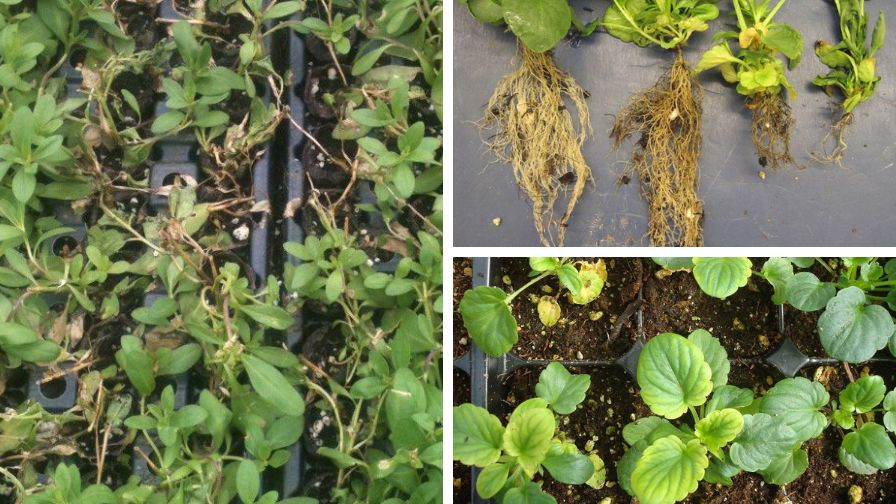
(Clockwise from left) Calibrachoa plugs dying from black root rot infection. Progression of severity and damage to pansy roots infected with black root rot. Pansy plants showing leaf yellowing that resembles nutritional deficiency symptoms. | Dr. Jean Williams-Woodward, University of Wyoming
Jean Williams-Woodward, formerly of the University of Georgia and currently at the University of Wyoming as an Associate Professor of Plant Pathology, Extension Plant Pathologist, and Director of the UW Extension Plant Diagnostic Lab, recently contributed an e-Gro Alert on the persistence of black root rot in bedding plant transplants, and steps growers can take to manage the fungal infection.
What Is Black Root Rot?
“Black root rot is caused by the fungus, Berkeleyomyces basicola (formerly Thielaviopsis basicola),” says Williams-Woodward. One of the main initial problems that allows this fungal infection to flourish is that its presence is often misdiagnosed, as its initial symptoms (yellowing, plant stunting) mimic nitrogen and iron nutrient deficiencies. However, this is because the infected roots are unable to absorb needed water and nutrients. These initial symptoms include:
Plants Susceptible to Black Root Rot
Common bedding plants that are susceptible to the fungal infection include:
- Begonias
- Calibrachoa
- Dianthus
- Dusty miller plants
- Geraniums
- Pansies
- Petunias
- Snapdragons
- Violas
- Vincas
Black Root Rot Symptoms and Identification
As previously mentioned, the initial symptoms of black root rot mimic those of nutritional deficiencies. However, one way to identify the issue is its isolation. Nutrient stress deficiencies will often uniformly affect the entire crop, while diseases are localized with a random symptom pattern.
Additionally, “Berkelyomyces root infection can often be difficult to see because the black roots, and more often just black root tips, are easily broken or washed from the roots during rinsing,” says Williams-Woodward. What black or darkened plant material in the roots can often be mistaken with Pythium, however, “the roots are not as soft and do not slough like with Pythium infection.” To catch minor infection early, microscopic examination of affected roots is often needed.
Black Root Rot Management Practices
Strict sanitation practices should be put in place to both prevent and, in the case of its discovery, eradicate Berkeleyomyces basicola from production facilities. However, the fungus spores can hide in the nooks and crannies of all types of surfaces, equipment, and plant material. Furthermore, it can also spread through gnats and shoreflies, necessitating insect control measures.
Control measures and management practices for black root rot include:
- Clean and disinfect all surfaces and containers.
- Check incoming plugs and plant material for healthy roots.
- Implement a dipping fungicide program.
- Keep rooting medium pH at or below 5.6.
- Use acidic ammonium-based fertilizers instead of calcium nitrate fertilizers.
- Use a microscope to inspect root samples for chlamydospores.
Lastly, any infected plant that has been identified should be safely disposed of.
For more information on management practices, such as product options to consider for disinfection and fungicide applications, please read the full e-Gro (Electronic Grower Resources Online) alert “Black Root Rot Is Still a Problem.” Additional and current e-Gro alert pieces from Volume 14 (2025) can be found online.

